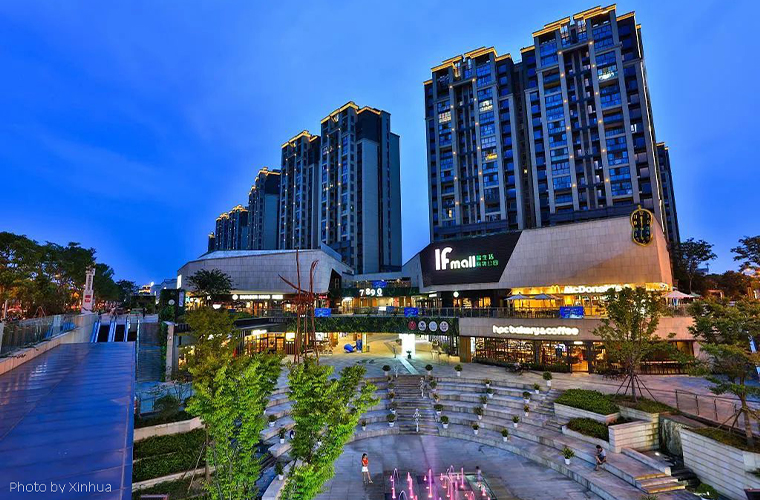



▲ The view shows Majian Commercial Square has upgraded to provide convenience services to residents within a 15-minute walk, Fengqiao subdistrict in Suzhou City, Jiangsu Province. [Xinhua]
1. Work Objectives.
By 2025, promote the construction of various types of “15-minute convenient life circles" across all eligible cities at or above the prefectural level nationwide. This initiative aims to develop a batch of convenient life circles that are reasonably laid out with complete function and excellent services. The circles are envisioned to be smart, efficient, fast, standardized and orderly, harmonious in both business and residential spaces. Further improve the level of convenience, standardization, intelligence, and quality of services to play a more pronounced role in facilitating the recovery and expansion of consumption. And achieve the goal of a comprehensive satisfaction rate of over 90% among all residents.
2. Key Implementation Tasks.
2.1 Systematically plan and design to optimize the layout of community commerce.
Adhere to the needs of the people with top-level design, innovate working methods, and incorporate the 15-minute convenient life circles into the residents’ deliberative consultation mechanism within neighborhoods and communities. Relevant cities should scientifically formulate comprehensive planning for the construction of 15-minute convenient life circles and sectoral planning for each life circle based on factors such as population distribution and consumer habits to translate residents' needs into project lists. Popularize the community planning system, enable designers to work within communities, strengthen professional instruction, rationally lay out commercial outlets, promote connectivity and integration of commercial and public facilities, and coordinate the commercial culture with consumption habits.
2.2 Improve consumption conditions and enrich residents’ consumption forms.
Within a 5 to 10-minute walk from residents' homes, priority will be given to providing essential services such as shopping, dining, home services, express delivery, and maintenance, along with the introduction of smart retail terminals to enhance convenience. Within a 15-minute walk from residents’ homes, develop quality enhancement businesses such as culture, entertainment, leisure, socialization, recreation, and fitness to provide a more comfortable consumption experience.
Developing “convenience stores and breakfast restaurants”. Support the development of various specialized and diversified market entities, promote branded convenience stores (community supermarkets) within communities, and offer services such as bill payment, parcel collection, and printing to enhance convenience. Build a multi-level breakfast supply system, increase the density of breakfast restaurants and diversity of breakfast varieties to ensure residents can “eat well”.
Addressing the “vegetable markets and repair shops” issue. Support the standardization and smart transformation of vegetable markets (vegetable shops), expand service forms, improve the environment, hygiene, and quality, and promote safe and affordable consumption. Standardize the development of community workshops for services like shoe repair and key cutting, and provide affordable repair services at transparent prices.
Serving the “elderly and young residents”. Encourage the construction and renovation of community elderly care facilities in accordance with aging standards, and support the use of ancillary facilities by elderly institutions to provide community elderly services. Explore the development of community canteens and establish elderly meal assistance service networks. Encourage the establishment of community nursing stations to provide home medical and nursing care services for the elderly. Encourage domestic helpers and caregivers to work in communities, and expand home elderly care services such as daily life care, health management, rehabilitation care, and emotional support. All types of consumer venues should retain traditional payment methods such as cash and bank cards as well as face-to-face services, while also establishing dedicated counters and experience stores for the elderly and mothers with infants. Encourage community business centers and other venues to set up facilities for mothers with infants and display guiding signs, develop embedded and standardized childcare institutions and places, and offer affordable services such as full-day care, half-day care, temporary care, and hourly care.
2.3 Innovate consumption scenarios and enhance diversified consumption experiences.
Transforming traditional commercial venues. Guide traditional shopping malls adjacent to residential areas to transform into community commercial centers, and expand service functions to include dining, daily retail, culture and leisure, children's entertainment, sports and fitness, and community canteens.
Developing new business models. Support the development of integrated online and offline instant retail models, and empower brick-and-mortar stores to expand their service radius. Support the introduction of fresh prepared vegetables into communities and supermarkets, and develop the "central kitchen + cold chain + dining" model to enhance the quality of prepared fresh food.
Stimulating the service consumption vitality. Encourage fitness centers, swimming pools, multi-functional sports venues, therapy shops, etc. to enter the communities to promote health-oriented consumption. Encourage communities to organize neighborhood festivals, food festivals, group-buying events, home appliances and household services promotions, and other consumption-promoting activities to enrich community commerce.
Facilitating integrated and coordinated development. Promote the integration of 15-minute convenience life circles with elderly care and childcare circles, culture and leisure circles, health and fitness circles, financial service circles, express service circles, etc. to create diversified and multi-level consumption scenarios.
Source:<https://www.gov.cn/zhengce/zhengceku/202307/content_6891466.htm>
<http://csj.news.cn/2023-07/28/c_1310734419.htm>
Edited and Translated by Guo Xinxin